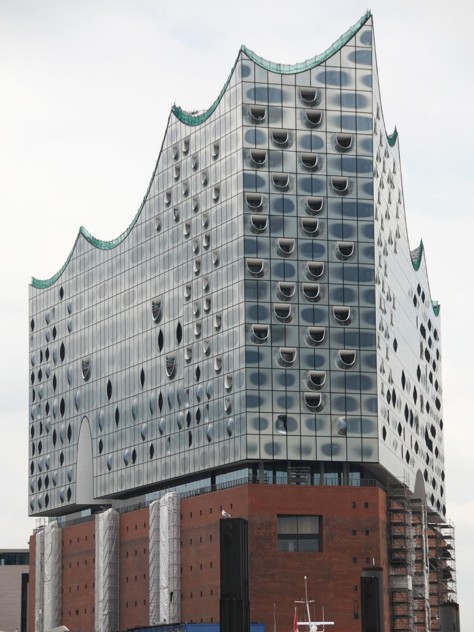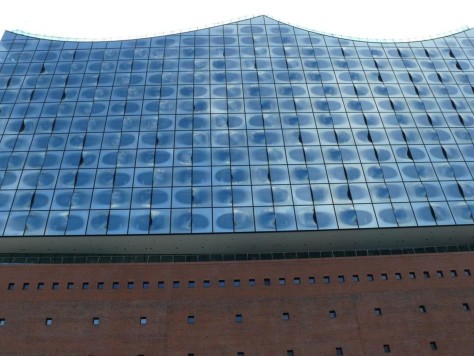
A New Place in the City – The City in a New Place
The Elbphilharmonie on the Kaispeicher in the midst of Hamburg’s HafenCity marks a location that was known to the public but not really accessible. In the future it will become a new center of social, cultural and daily life not only for the people of Hamburg but for visitors from all over the world.

The Kaispeicher A was still in use as a warehouse until the end of the last century. This solid and weighty construction will now be put to new use: it will support the Philharmonic. It will now bear on top the load that it once carried within its walls. Our interest in the warehouse lies not only in its unexploited structural potential but also in its architecture.

The robust, almost aloof architecture of the Kaispeicher provides a surprisingly ideal foundation for the new Philharmonic hall. It seems to be part of the landscape and not yet really part of the city, which is now spreading out to include the area. The harbor warehouses of the 19th century adopted the urban vocabulary of the city’s historical façades — but not the Kaispeicher A. Despite the contextual choice of bricks as a building material, the façades of this massive and mighty warehouse are strikingly radical and abstract.

The new building has been extruded from the shape of the Kaispeicher. While rising above the brick block of the older building with an identical ground plan, the top and bottom of the new structure are fundamentally different from the calm and simple form of the warehouse below: the broad, undulating shape of the roof rises to a total height of 110 m at the Kaispitze (the tip of the peninsula), sloping down to the eastern end, where the roof is 30 m lower.

The bottom of the new structure, on top of the warehouse, is a lively animated plaza, divided into zones defined by expansive vaulting, ranging from flat to very steep. An arch cut into the side wall affords views of the sky and spectacular, theatrical vistas across the river Elbe river and downtown Hamburg. Deep recesses cut into the building above the plaza provide views of the foyers on several levels.

In contrast to the stoic brick façade of the Kaispeicher, the Philharmonic, clad in variously curved and cut panels of glass, looks like an immense crystal, whose appearance keeps changing as it captures and combines reflections from the sky, the water and the city. The main entrance to the Kaispeicher lies to the east. Curving slightly as it leads to the plaza, the elongated escalator that provides access cannot be seen in full from one end to the other.

It is a spatial experience in itself, transporting users through the entire warehouse, passing a large panorama window and translating the spirit of the sweeping staircases in fin de siècle concert halls into a contemporary idiom. Upon reaching the top of the Kaispeicher, visitors step onto a spacious terrace, a new plaza high above the city. Perched on top of the Kaispeicher, it is like a gigantic joint between the two elements of the structure and creates a new space for public use that also provides access to the foyer of the new concert hall.

The design of the Philharmonic is clearly a 21st century project that would have been inconceivable before. What has been retained is the fundamental idea of the Philharmonic as a space where orchestra and conductor are located in the midst of the audience and where the architecture and the arrangement of the tiers take their cue from the logic of the acoustic and visual perception of music, performers and audience.

Here, however, that logic leads to another conclusion; the tiers extend higher into the overall space so that the tiers, walls, and ceiling form a homogeneous whole. The complex geometry of the hall unites organic flow with incisive, more static shapes. Rising vertically almost like a tent, the concert hall seats 2150 people to enjoy the pleasures of making and listening to music.

Its towering shape defines the structure of the entire volume of the building and is correspondingly reflected in the silhouette of the building as a whole. As a landmark visible from afar, the Elbphilharmonie will lend the horizontally oriented city an entirely new accent, symbolizing Hamburg’s foray into the new territory of the harbor area along the shores of the Elbe. Source by Herzog & de Meuron.

Location: Hamburg, Germany
Architects: Herzog & de Meuron
Partner: Jacques Herzog, Pierre de Meuron, Ascan Mergenthaler (Partner in Charge), David Koch (Partner in Charge)
Project Team: Jan-Christoph Lindert (Associate, Project Manager), Nicholas Lyons (Associate, Project Architect), Stefan Goeddertz (Associate, Project Architect), Stephan Wedrich (Associate), Christian Riemenschneider (Associate), Carsten Happel (Associate), Kai Strehlke (Head Digital Technologies), Stephan Achermann, Sabine Althaber, Christiane Anding, Thomas Arnhardt, Petra Arnold, Tobias Becker, Johannes Beinhauer, Uta Beissert, Lina Belling, Andreas Benischke, Inga Benkendorf, Christine Binswanger (Partner), Johannes Bregel, Francesco Brenta, Jehann Brunk, Julia Katrin Buse, Ignacio Cabezas, Jean-Claude Cadalbert, Sergio Cobos Álvarez, Massimo Corradi, Guillaume Delemazure, Annika Delorette, Fabian Dieterle, Annette Donat, Patrick Ehrhardt, Carmen Eichenberger, Stephanie Eickelmann, Magdalena Agata Falska, Daniel Fernandez, Hans Focketyn, Birgit Föllmer, Bernhard Forthaus, Andreas Fries, Asko Fromm, Catherine Gay Menzel, Marco Gelsomini, Ulrich Grenz, Jan Grosch, Jana Grundmann, Hendrik Gruss, Luís Guzmán Grossberger, Christian Hahn, Yvonne Hahn, Naghmeh Haji Beik, David Hammer, Michael Hansmeyer, Nikolai Happ, Bernd Heidlindemann, Jutta Heinze, Magdalena Hellmann, Anne-Kathrin Hellermann, Mirco Hirsch, Volker Helm, Lars Höffgen, Robert Hösl (Partner), Philip Hogrebe, Ulrike Horn, Michael Iking, Ina Jansen, Nils Jarre, Jürgen Johner (Associate), Leweni Kalentzi, Andreas Kimmel, Anja Klein, Frank Klimek, Julia Kniess, Uwe Klintworth, Alexander Kolbinger, Benjamin Koren, Tomas Kraus, Jonas Kreis, Nicole Lambrich, Jens Lehmann, Matthias Lehmann, Monika Lietz, Felix Morczinek, Philipp Loeper, Thomas Lorenz, Christina Loweg, Florian Loweg, Femke Lübcke, Tim Lüdtke, Lilian Lyons, Klaus Marten, Jan Maasjosthusmann, Petrina Meier, Götz Menzel, Alexander Meyer, Simone Meyer, Henning Michelsen, Alexander Montero Herberth, Felix Morczinek, Jana Münsterteicher, Christiane Netz, Andreas Niessen, Monika Niggemeyer, Monica Ors Romagosa, Argel Padilla Figueroa, Benedikt Pedde, Sebastian Pellatz, Malte Petersen, Jorge Picas de Carvalho, Philipp Poppe, Alrun Porkert, Yanbin Qian, Robin Quaas, Leila Reese, Constance von Rège, Chantal Reichenbach, Thorge Reinke, Ina Riemann, Nina Rittmeier, Dimitra Riza, Miquel Rodríguez (Associate), Christoph Röttinger, Guido Roth, Henning Rothfuss, Peter Scherz, Sabine Schilling, Chasper Schmidlin, Alexandra Schmitz, Martin Schneider, Leo Schneidewind, Malte Schoemaker, Katrin Schwarz, Henning Severmann, Nadine Stecklina, Markus Stern, Sebastian Stich, Sophie Stöbe, Stephanie Stratmann, Ulf Sturm, Stefano Tagliacarne, Anke Thestorf, Katharina Thielmann, Kerstin Treiber, Florian Tschacher, Chih-Bin Tseng, Jan Ulbricht, Florian Voigt, Maximilian Vomhof, Christof Weber, Lise Wendler, Philipp Wetzel, Douwe Wieërs, Julius Wienholt, Julia Wildfeuer, Boris Wolf, Patrick Yong, Kai Zang, Xiang Zhou, Bettina Zimmermann, Christian Zöllner, Marco Zürn
General Designer: Consortium PlanerArge Elbphilharmonie Hamburg:
– Herzog & de Meuron GmbH, Hamburg, Germany
– H+P Planungsgesellschaft mbH & Co. KG, Aachen, Germany
– Hochtief Solutions AG, Essen, Germany
Acoustics: Nagata Acoustics Inc., Los Angeles / Tokyo, USA / Japan
General Contractor: Adamanta Grundstücks-Vermietungsgesellschaft mbH & Co., Düsseldorf, Germany with Hochtief Solutions AG, Essen, Germany
Client: Freie und Hansestadt Hamburg, Germany; represented by ReGe Hamburg Project-Realisierungsgesellschaft mbH, Hamburg, Germany
Site Area: 10’540sqm / 113’452sqft
Gross Floor Area: 120’383sqm / 1’295’792sqft
Number of Levels: 26 floors
Year: 2016
Photographs: Silesia 711








